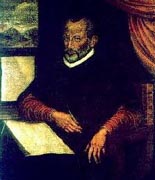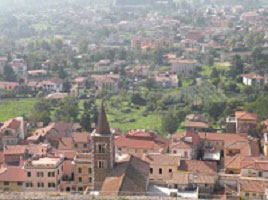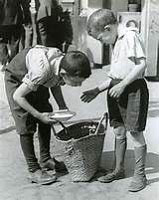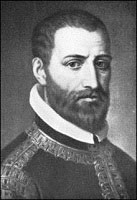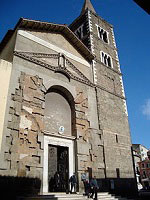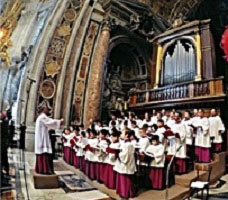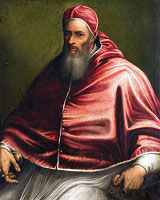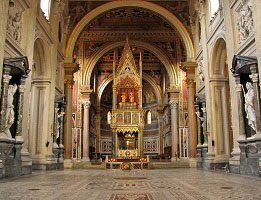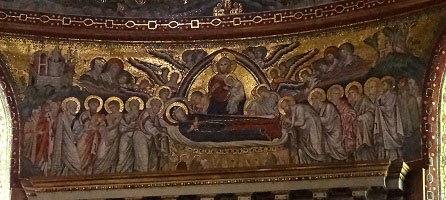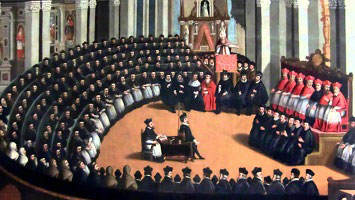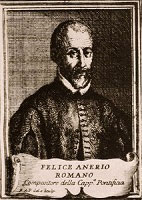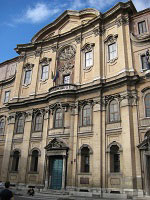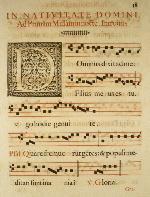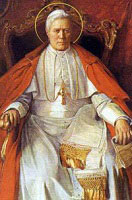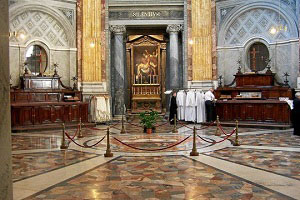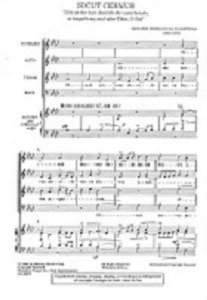

|
| Musical Musings: Composers |
|
|
Pivotal Player: PalestrinaBishop Robert Barron has been called by many the Fulton Sheen of our times. His Word on Fire ministries have produced outstanding resources for "Procliming Christ in the Culture." Prior to his being named auxiliary bishop of Los Angeles, he began a sequel to his excellent video series Catholicism called Catholicism: The Pivotal Players, commenting on important figures in the life of the Church. These six videos are complete:
The project was interrupted by his episcopal ordination and new duties, but Bishop Barron has begun Volume 2 of this collection, to include:
I submit there is perhaps another figure who could make this list:
Born in 1525 to a farming family in the village of Palestrina (close to Rome), Pierluigi was apparently a talented young singer.
G.O. Pitoni commented that the boy sang in the Roman streets, peddling produce from the family farm before being "discovered" by the Maestro di cappella of the Basilica of Saint Mary Major, who trained him in music.
He was also taught by Jacob Arcadelt (of Ave Maria fame), who worked in Rome from 1539-1549.
The young musician's first job, in 1549, was as organist and choir master at the Cathedral of Saint Agapito in his native village of Palestrina.
In 1551 he was called to nearby Rome to train the choir boys at Saint Peter's Basilica. The same year, he was appointed choirmaster of the cappella Guilia, the choir for the canons of the basilica.
His first compositions appeared in 1554, a set of SATB Masses dedicated to Pope Julius III, the former bishop of Palestrina. The pope appointed him a member of the Papal Chapel, a position normally reserved to clergy. This was not without animosity from the other members and Pope Paul IV eventually dismissed him, albeit with a small pension.
From 1555-1561 he served as Maestro di cappella at the Basilica of Saint John Lateran.
He returned to Saint Mary Major, also as Maestro di cappella, from 1561-1566.
The Council of Trent (1545-1563) spoke strongly as the Catholic Counter-Reformation gained momentum. The reforms of the council were entrusted to a committee of eight cardinals (sound familiar?), aomng whom Cardinal Vitellozo Vitelli and Saint Charles Borromeo were tasked with examining music and the papal choirs. Conciliar pronouncements concerning music were two:
Saint Charles Borroemo became a strong patron of Palestrina and his music.
Pope Pius IV created the role of "Composer of the Papal Chapel" and conferred it on Palestrina as a token of his pleasure. Felice Anerio was the only other composer to subsequently hold this position.
In 1571 Palestrina was named to the prestigious position of Maestro di cappella at Saint Peter's Basilica, a job he held in conjunction with two others: Maestro di cappella of the Oratory of Saint Philip Neri in Rome and Instructor at the Music School of Giovanni Maria Nanino. Palestrina drew much inspiration from the spirituality of Saint Philip Neri.
He collaborated on editions of Gregorian chants with Guidetti, Anerio and Suriano, with limited success. His time at the Vatican Basilica was marked with great grief. His brother died in 1572, two sons in 1575, and his wife in 1580. Although he considered priestly ordination, he ultimately married again, to a wealthy widow. His subsequent financial stability allowed him ample time to compose.
He took on the position of Maestro di cappella to Prince Buoncompagni, a nephew of Pope Gregory XIII, in 1581. His musical output was comfortable and splendid during this time. All told, Palestrina's works number about 1000 and fill 33 volumes, currently published by Breitkopf & Hartel over many years. The last of these volumes was presented to Pope Saint Pius X on Easter Monday 1908.
Giovanni Pierluigi da Palestrina died of pleurisy on February 2, 1594, the Feast of the Purification of the Blessed Virgin Mary. His plain wooden coffin bore the inscription, "The Prince of Music," as well as a lead plate with the prayer, "Libera me, Domine." A five-part psalm for three choirs was sung at his funeral in the basilica. He was buried beneath the floor, but alas his tomb was destroyed in the late 1700s with the construction of a new sacristy.
Palestrina earned the moniker, "Savior of Church Music" for his ambitious dedication to the ideals of quality sacred music. Joseph Otten wrote: His creations will for all time stand forth as the musical embodiment of the spirit of the Counter-Reformation, the triumphant Church.
His music shows the influences of Northern European style (Dufay and des Prez). He wrote what came to be known as "smooth polyphony," typical of the late Renaissance. One can find mostly stepwise melodic motion in his music, with dissonances reserved to weak beats, producing a rather consonant and very pleasant sound.
Article written 16 August 2016 See Palestrina in the CNP catalog: |
Submit Your Music / Contact Us / Company Description / Links
